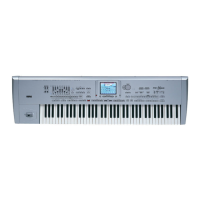102
Style Record mode
The Style structure
By entering the Style Record mode, you can create your own
Styles, or edit an existing Style.
The Style structure
The term “Style” relates with music sequences automatically
played by the arranger of the Pa1X. A Style consists of a pre-
defined number of Style Elements (E) (Pa1X features twelve dif-
ferent Style Elements: Variation 1-4, Intro 1-3, Fill 1-3, Ending
1-2). When playing, these Style Elements can be selected directly
from the control panel, using the corresponding buttons.
To explain the Style structure, we can use a tree-structure, as
shown in the following diagram:
Each Style Element is made up of smaller units, called Chord
Variations (CV), but not all of them have the same number of
CVs. Variations 1-4 have up to 6 CVs each, while the other Style
Elements have only up to 2 CVs.
When you play on the chord recognition area (Lower, Upper or
Full, depending on the Chord Scanning section on the control
panel), the arranger scans the keyboard and determines which
chord you are playing. Then, depending on the selected Style
Element, it determines which Chord Variation (CV) should be
played for the scanned chord. Which Chord Variation corre-
sponds to each scanned chord is a setting of the Style: the Chord
Variation Table. Each Style Element contains a Chord Variation
Table, whose prototype is the following:
After deciding what CV to play, the arranger triggers the right
sequence for each track. Since each sequence is written in a par-
ticular key (for example, CMajor, GMajor or Emin), the
arranger transposes it according to the scanned chord. Notes in
the sequence are carefully transposed according to the Note
Transposition Tables (NTT), to make them work fine with all
recognized chords. The NTT allows you to record just some
Chord Variations, and have all the notes play in the right place,
avoiding dissonances and transposing the pattern notes to the
notes of the recognized chord.
Going deeper into the Style structure, we can see that each
Chord Variation is made up of Track Sequences, and the Pa1X
supports 8 different tracks. DRUM and PERC are used for drum
and percussion sequences, BASS for bass and ACC1-5 are for
Style Record mode
o
Ball
V
at
n
c
V
CV
CV
V
V
ti
n
V
ti
n
Va
ati
n
Intr
V
CV
Intr
Intr
/C.I
Fill
/Break
En
in
En
in
Chord Chord Variations (CVs)
Variation 1-4 Intro 1-3, Fill 1-3, Ending 1-2
Maj
CV1 – CV6 CV1 – CV2
6
M7
M7b5
Sus4
Sus2
M7sus4
min
m6
m7
m7b5
mM7
7
7b5
7sus4
dim
dimM7
aug
aug7
augM7
no 3rd
no 3rd, no 5th

